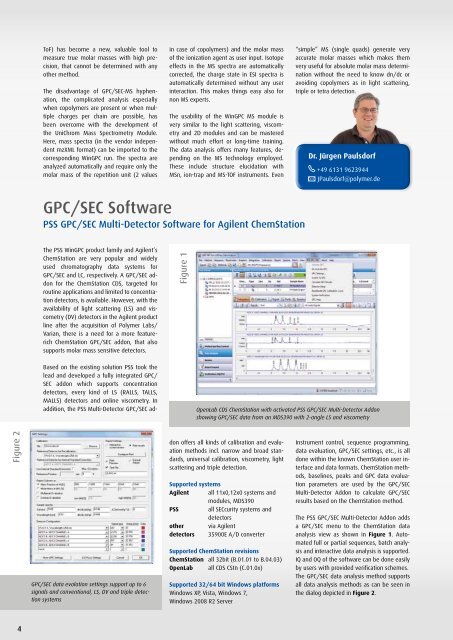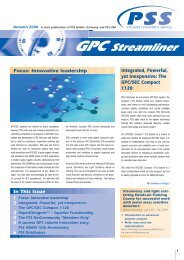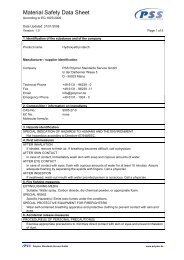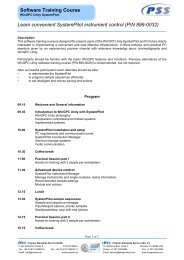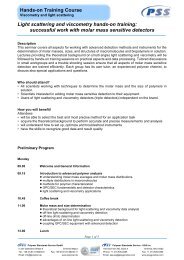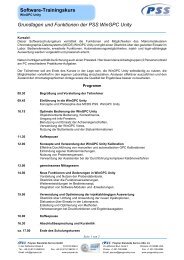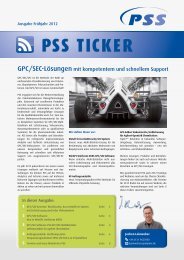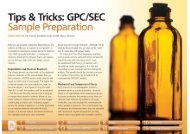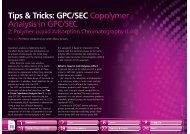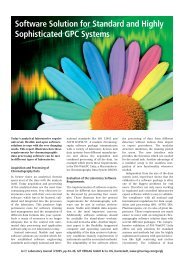GPC STREAMLINER - PSS
GPC STREAMLINER - PSS
GPC STREAMLINER - PSS
- TAGS
- streamliner
- polymer.de
You also want an ePaper? Increase the reach of your titles
YUMPU automatically turns print PDFs into web optimized ePapers that Google loves.
Figure 2<br />
4<br />
ToF) has become a new, valuable tool to<br />
measure true molar masses with high precision,<br />
that cannot be determined with any<br />
other method.<br />
The disadvantage of <strong>GPC</strong>/SEC-MS hyphenation,<br />
the complicated analysis especially<br />
when copolymers are present or when multiple<br />
charges per chain are possible, has<br />
been overcome with the development of<br />
the UniChrom Mass Spectrometry Module.<br />
Here, mass spectra (in the vendor independent<br />
mzXML format) can be imported to the<br />
corresponding Win<strong>GPC</strong> run. The spectra are<br />
analyzed automatically and require only the<br />
molar mass of the repetition unit (2 values<br />
<strong>GPC</strong>/SEC Software<br />
<strong>PSS</strong> <strong>GPC</strong>/SEC Multi-Detector Software for Agilent ChemStation<br />
The <strong>PSS</strong> Win<strong>GPC</strong> product family and Agilent’s<br />
ChemStation are very popular and widely<br />
used chromatography data systems for<br />
<strong>GPC</strong>/SEC and LC, respectively. A <strong>GPC</strong>/SEC addon<br />
for the ChemStation CDS, targeted for<br />
routine applications and limited to concentration<br />
detectors, is available. However, with the<br />
availability of light scattering (LS) and viscometry<br />
(DV) detectors in the Agilent product<br />
line after the acquisition of Polymer Labs/<br />
Varian, there is a need for a more featurerich<br />
ChemStation <strong>GPC</strong>/SEC addon, that also<br />
supports molar mass sensitive detectors.<br />
Based on the existing solution <strong>PSS</strong> took the<br />
lead and developed a fully integrated <strong>GPC</strong>/<br />
SEC addon which supports concentration<br />
detectors, every kind of LS (RALLS, TALLS,<br />
MALLS) detectors and online viscometry. In<br />
addition, the <strong>PSS</strong> Multi-Detector <strong>GPC</strong>/SEC ad-<br />
<strong>GPC</strong>/SEC data evalation settings support up to 6<br />
signals and conventional, LS, DV and triple detection<br />
systems<br />
in case of copolymers) and the molar mass<br />
of the ionization agent as user input. Isotope<br />
effects in the MS spectra are automatically<br />
corrected, the charge state in ESI spectra is<br />
automatically determined without any user<br />
interaction. This makes things easy also for<br />
non MS experts.<br />
The usability of the Win<strong>GPC</strong> MS module is<br />
very similar to the light scattering, viscometry<br />
and 2D modules and can be mastered<br />
without much effort or long-time training.<br />
The data analysis offers many features, depending<br />
on the MS technology employed.<br />
These include structure elucidation with<br />
MSn, ion-trap and MS-TOF instruments. Even<br />
Figure 1<br />
OpenLab CDS ChemStation with activated <strong>PSS</strong> <strong>GPC</strong>/SEC Multi-Detector Addon<br />
showing <strong>GPC</strong>/SEC data from an MDS390 with 2-angle LS and viscometry<br />
don offers all kinds of calibration and evaluation<br />
methods incl. narrow and broad standards,<br />
universal calibration, viscometry, light<br />
scattering and triple detection.<br />
Supported systems<br />
Agilent all 11x0,12x0 systems and<br />
modules, MDS390<br />
<strong>PSS</strong> all SECcurity systems and<br />
detectors<br />
other via Agilent<br />
detectors 35900E A/D converter<br />
Supported ChemStation revisions<br />
ChemStation all 32bit (B.01.01 to B.04.03)<br />
OpenLab all CDS CStn (C.01.0x)<br />
Supported 32/64 bit Windows platforms<br />
Windows XP, Vista, Windows 7,<br />
Windows 2008 R2 Server<br />
“simple” MS (single quads) generate very<br />
accurate molar masses which makes them<br />
very useful for absolute molar mass determination<br />
without the need to know dn/dc or<br />
avoiding copolymers as in light scattering,<br />
triple or tetra detection.<br />
Dr. Jürgen Paulsdorf<br />
+49 6131 9623944<br />
jPaulsdorf@polymer.de<br />
Instrument control, sequence programming,<br />
data evaluation, <strong>GPC</strong>/SEC settings, etc., is all<br />
done within the known ChemStation user interface<br />
and data formats. ChemStation methods,<br />
baselines, peaks and <strong>GPC</strong> data evaluation<br />
parameters are used by the <strong>GPC</strong>/SEC<br />
Multi-Detector Addon to calculate <strong>GPC</strong>/SEC<br />
results based on the ChemStation method.<br />
The <strong>PSS</strong> <strong>GPC</strong>/SEC Multi-Detector Addon adds<br />
a <strong>GPC</strong>/SEC menu to the ChemStation data<br />
analysis view as shown in Figure 1. Automated<br />
full or partial sequences, batch analysis<br />
and interactive data analysis is supported.<br />
IQ and OQ of the software can be done easily<br />
by users with provided verification schemes.<br />
The <strong>GPC</strong>/SEC data analysis method supports<br />
all data analysis methods as can be seen in<br />
the dialog depicted in Figure 2.


